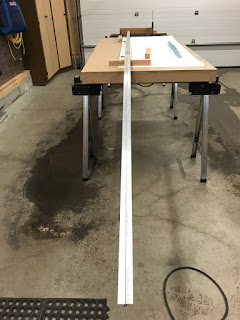I'm glad to be finished the big bend or curve as it was very nerve wracking. I was terrified of ruining the longeron, but in retrospect it wasn't that difficult. Just quite time consuming and a little frustrating as the plans suggest. An I too agree that its best done when broke into small segments.
Fortunately the sharp downward bend goes much quicker. I was careful not to put a sharp edge on the piece of oak that i'm using using for a bending block (its 1/8" radius) as I have found in the past bending aluminum around sharp corners can cause cracks at least with thin material....so why stop now.

I was having a tough time figuring out how best to set up for measurement of the 2 3/4" drop. I have a bike stand that I used to clamp a wood ruler onto.


It looks good in theory, but in actual fact it doesn't work so well. I ended up in the end just simply using the straight clamped across the top and using a ruler to measure the drop. The sharp bend down causes quite the bend in the other direction so ultimately the stand just gets in the way.
To promote a clean sharp bend at the 28 1/4" mark, I locked the angle down in the vice and clamps.

I began to bend, check, correct for straightness, bend some more, so on, and so on. I managed to get one finished fairly quickly. But it is time consuming to remove the clamps just to do the measurements. One all done...Measures 2 3/4" apart from the unbent one.

Now its 5 1/2" apart when both are bent, and more importantly both are perfectly aligned.

Best of all, it matches the skin perfectly.




















































